
The Secrets of Retailing Success on Amazon: Strategies for Thriving in the Digital Marketplace
The cost of setting up as an Amazon retailer can vary widely depending on various factors, including the type of products you plan to sell, your chosen fulfillment method, and you’re marketing and advertising strategies. Here are some of the potential costs associated with becoming an Amazon retailer:
Amazon Seller Account: There are two main types of Amazon seller accounts: Individual and Professional. The Individual account is free but charges a fee for each item sold, while the Professional account requires a monthly subscription fee (as of my last knowledge update in September 2021, it was $39.99 per month). The choice between these two account types depends on your expected sales volume.
Product Costs: This includes the cost of acquiring or manufacturing the products you plan to sell on Amazon. It can vary significantly depending on the type of products you offer.
Fulfillment Costs: If you choose to fulfill orders yourself (Fulfillment by Merchant – FBM), you’ll incur costs related to shipping, packaging materials, and storage space. If you opt for Amazon’s fulfillment services (Fulfillment by Amazon – FBA), you’ll pay fees for storage, picking, packing, and shipping, in addition to any necessary labelling and prep fees.
Amazon Referral Fees: Amazon charges referral fees based on the category of the product you sell. These fees are a percentage of the item’s sale price and can range from around 6% to 45% or more, depending on the category. Food specifically is · 8% for products with a total sales price of CAD $20.00 or less, and
· 15% for products with a total sales price greater than CAD $20.00
Variable Closing Fees: Certain categories may have variable closing fees in addition to referral fees.
Shipping Costs: If you handle shipping yourself, you’ll need to cover the cost of shipping your products to customers. If you use FBA, you’ll pay for shipping your inventory to Amazon’s fulfillment centers.
Advertising and Marketing: If you choose to run Amazon Advertising campaigns to promote your products, there will be advertising costs associated with this. The amount you spend on advertising can vary based on your marketing strategy. Again, we have clients spending $500.00 to $1000.00 per month in the food space with some great success.
Professional Services: Some sellers may choose to hire professionals or agencies for tasks like product photography, listing optimization, and advertising management, which can incur additional costs.
Amazon Brand Registry: Enrolling in Amazon’s Brand Registry program, if applicable, may involve associated fees.
Software and Tools: Many sellers invest in third-party software and tools for tasks like inventory management, analytics, and competitor research, which can have monthly subscription fees.
Taxes and Compliance: You may need to budget for taxes, permits, licenses, and compliance-related expenses, depending on your location and the nature of your business.
Returns and Refunds: Be prepared for potential costs associated with handling returns and refunds, including return shipping costs and restocking fees.
It’s important to note that while there are costs involved in selling on Amazon, the potential for revenue and profit can be significant, especially if you offer competitive products and effectively market them.
To determine your specific costs, it’s advisable to create a detailed business plan, taking into account all potential expenses and revenue projections. Additionally, Amazon’s fee structure and policies may change over time, so it’s essential to check Amazon’s official Seller Central website for the most up-to-date information on fees and costs.
Read about the New Challenges a New Brand Faces
